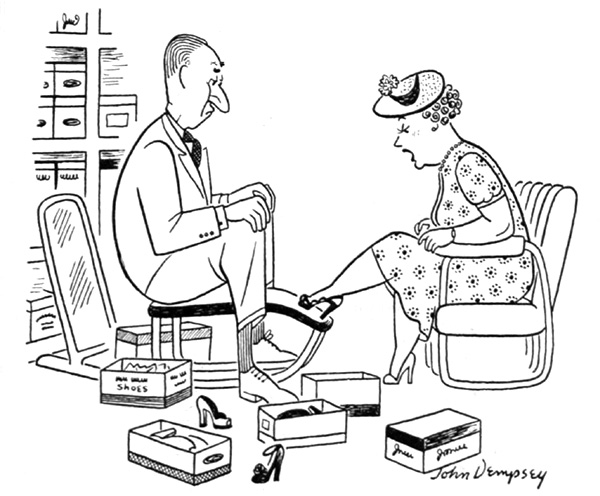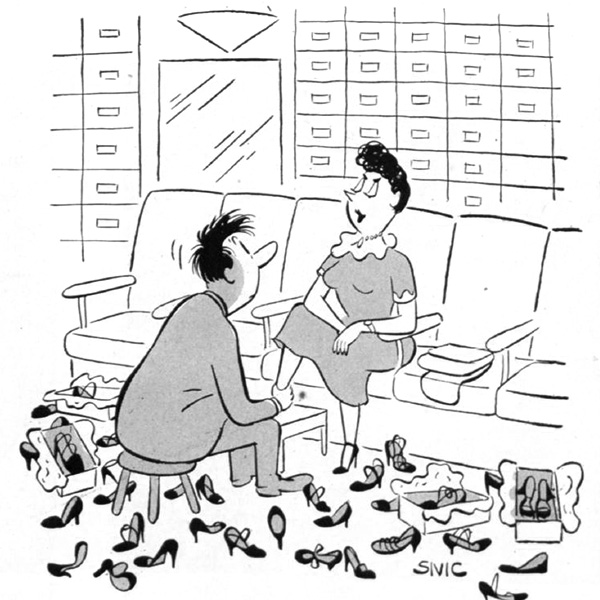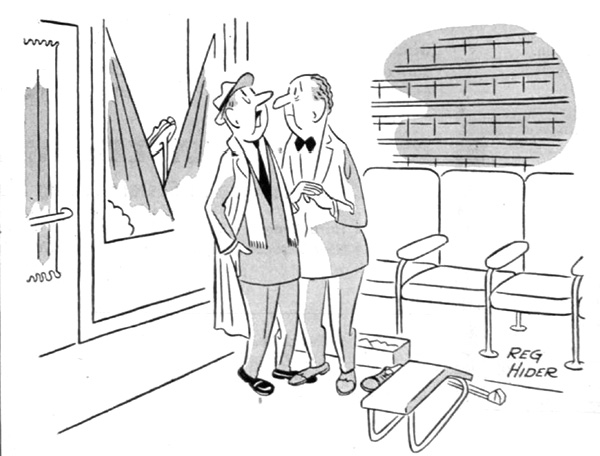Cartoons: Shoe Store Shenanigans
Want even more laughs? Subscribe to the magazine for cartoons, art, inspiring stories, fiction, humor, and features from our archives.

Ronson
September 13, 1952

John Dempsey
June 9, 1951

Marty Lowenstein
October 4, 1952

Sivic
May 17, 1952

Reg Hider
January 5, 1952

Chon Day
November 17, 1951

M. Blanchard
September 20, 1952
Want even more laughs? Subscribe to the magazine for cartoons, art, inspiring stories, fiction, humor, and features from our archives.
Sneaker Madness
Gucci, the luxury-goods maker, last year began selling a line of sneakers that come pre-smudged. That’s right, filthy from the get-go. For a pair of these, Gucci will gladly accept your $870.
What’s that, you say? You’d like something a little more obnoxious? Okay, hand over $1,590 and Gooch will attach a strand of crystals to those scruffy shoes. Happy now?
Conventional aesthetic standards barely apply in the hypercompetitive world of “kicks” — which is, ya know, the street parlance. Each week’s most lust-worthy new models invariably sell out in a flash. Some go on to become collectibles. The sneakersphere after-market is not unlike the liveliness observed in the fenced-jewelry game. Except that top sneakers often fetch way more cash.
Fact: The American footwear market is on a tear, expected to reach an astonishing $320 billion annually within four years, according to Zion Market Research. Where’s all that growth coming from? You guessed it.
For the way we Americans live today, sneakers are the perfect fit: comfortable, casual, endlessly customizable. To be clear, they are more about fashion — sometimes freaky fashion — than performance.
“Sneakers can help us stand out or blend in,” writes Nicholas Smith in his new book Kicks: The Great American Story of Sneakers. “Every sneaker we wear says something about us in both subtle and not-so-subtle ways.”
The other day I spotted a pair of high-top sneakers that featured a pattern of dainty pink flowers — and these were for men. I also noticed some folks wearing bold kicks to a funeral. (Okay, this was in L.A., but still.) The point is that sneakers have evolved from predictably boring footwear into functional art. They’ve found soul.
A pair of super-rare ’70s-era Nikes sold for a record $437,500 at auction earlier this year.
Expect to lay out hundreds of dollars for a popular model. A pair of super-rare ’70s-era Nikes sold for a record $437,500 at auction earlier this year.
That’s batty. But let’s be honest, the luxe fashion industry bathes in batty. And as much as I’m a rational guy, brimming with ordinariness, I choose — much to my own surprise — to celebrate a world in which the old-timey Converse brand no longer rules the sneaker roost. Here is everyone’s socially acceptable opportunity to express their inner crazy.
Most sneakers — men’s and women’s — fall into clear categories: The popular urban look favors a chunky sole and, often, vibrant slashes of color; the much-ridiculed dad shoe is more of a walker and generally fails to light up the scoreboard, but it has its adherents; and, finally, the homages. Examples among this last: beer-themed sneakers, models that honor the ’60s, and even — I swear this is true — a new bizarro pair that pays respects to the French croissant.
When the editor of Sneaker Freaker wrote in an early issue of the magazine that “Sneakers can be seen by non-believers as a flippant concern,” he worried that his budding hobby might not have legs. He needn’t have. The trend is so powerful that a respected publication recently ran a story headlined “Why Sneaker Culture Should be Taught in Schools.”
The ultimate validation may have been bestowed by a company that’s begun marketing so-called Shoe Condoms to obsessive sneakerheads. Waterproof. $10.99 per pair. Seems totally prudent to me.
In the last issue, Cable Neuhaus wrote about handwritten letters.
Featured image: Shutterstock.
Nine Steps to Finding the Perfect Shoe
About 75 percent of the nearly 800,000 surgeries performed for bunions and the other most common foot problems are caused by poorly fitting shoes, according to the American Orthopedic Foot & Ankle Society.
Consumers can prevent painful feet by simply buying shoes that fit. Ron Harris, director of product logistics at Munro & Company, offers the following tips.
- Start by having both feet measured. Some people’s feet change sizes as they age, have children, gain or lose weight, or change physical activities.
- Because most people have one foot larger than the other, be sure you pick a shoe that fits your larger foot comfortably. You can always add an insert or pad to the shoe for the smaller foot.
Shoe sizes are not universally standardized. “Different brands and different styles within a brand will fit differently,” Harris says. “A shoe labeled 8 ½ may fit like an 8 or may fit like a 9.” The half-size of a shoe is only one-sixth of an inch. - Even with a company like Munro that makes 75 different sizes per style to ensure the right fit, the same woman may wear different sizes in different styles because of the shape of her foot.
“Most of our customers can wear all of our shoes in the same size, but not all of our customers can,” Harris says. If someone has a high instep, for example, she may have to wear a different size for a low-cut pump than she would for a boot. - Select shoes that conform to the shape of your foot. You can still wear a pump that fits comfortably, as long as you don’t try to squeeze your toes into the point. The widest part of your foot should fit into the widest part of the shoe. “You’re going to have to have some room at the end.”
- That half-inch space between the end of your toes and the shoe isn’t just for kids. Harris says everyone should have up to half an inch between their longest toe and the end of the shoe.
- Slippage is good—just not too much. As we walk, our feet have to have room to bend within the shoes. If you don’t have enough room, you’ll get blisters or “pump bumps,” calcium deposits caused from chronic irritation or rubbing. “If you cannot pull your heel out of a shoe while standing, the shoe is probably too short or narrow.”
- The shoe should feel comfortable when you walk around the store. If it hurts in the store, it’ll hurt when you wear it.
- Try to recreate the conditions under which you’ll be wearing the shoes. If you’re the kind of person who is on your feet all day, your feet swell as the day goes on. So it’s best to try on shoes in the evening.
- If you wear orthotics, take them with you for your fitting. “The slightest difference from the insert or insole can have a drastic effect on the fit of your shoes,” he says. Orthotics affect the size and fit of a shoe, so if you buy shoes without seeing how they fit with the orthotics, “it could completely defeat the purpose of the orthotics.”
- Try on shoes with the same type or weight of socks you’ll be wearing with the shoe. For example, don’t wear trouser socks to try on dress shoes if you’ll be wearing the shoes with nylons. And don’t wear nylons to try on athletic shoes. “They need to fit in the same environment in which you need the shoes,” he says.
And to get the most life out of your shoes, Harris advises never to never wear the same shoes two days in a row, so they can dry out naturally.